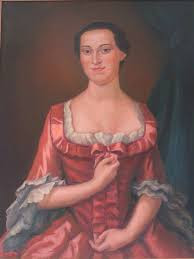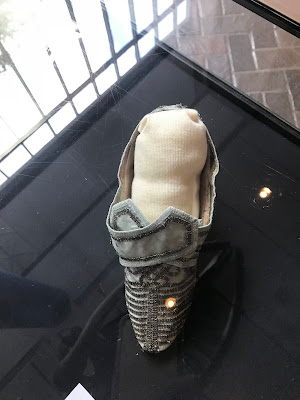The celebration began with the rededication of the graves of Lesslie Donom Witherspoon, Organizing Chapter Regent followed by Virginia Mason Bratton, 4th State Regent of the SCDAR at Rose Hill Cemetery. Ironically, these graves were just feet apart from each other making the transition between the two seamless. Afterwards, we traveled 3 blocks to the Episcopal Church of the Good Shepherd assembly room for a thoughtfully prepared program and delicious refreshments.
In typical paging fashion, I saw that our State Chaplain had no where to place her purse during the ceremony and naturally held it for her during the ceremony and then carried it for her back to her car while keeping an eye that she didn't stumble or fall as we made our way over the uneven terrain. For those of you who have worn white in DAR and served our society in that fashion, I imagine you are nodding your heads reminiscing of how many times you have done that exact same thing while not wearing white. The servant's heart doesn't go away does it?
Attendees gathered at the grave of Organizing Chapter Regent Lesslie Witherspoon.
Miss Witherspoon joined DAR on April 2, 1896 citing the service of Captain James Witherspoon. She was the daughter of Margaret Elizabeth Wright and Isaac Donom Witherspoon. She served as chapter regent from 1898-1902.
We then moved over to the grave of Virginia Mason Bratton.
Virginia Mason Bratton joined DAR on October 1, 1896 citing the services of George Mason and William Bratton. Virginia was the daughter of Minnie Mason and Napoleon Bonaparte Bratton. She served as our 4th State Regent.
Chapter Regent Anne Allen shared this with us.
Death
Takes Member of Pioneer York Family
“Mrs.
Virginia Mason Bratton, 92, a leader in the DAR and UDC, a friend of governors
and legislators and a prominent member of a pioneer York County family, died
last night after a long period of declining health.
She
was the widow of Robert Moultrie Bratton of York. “Miss Virginia” as she was
known, was born on September 9, 1867, at the Brattonsville Plantation near
York, the ancestral home of the Bratton family, in the historic revolutionary
house where her great-grandfather and great-grandmother Col. William and Martha
Bratton, lived at the time of the Revolutionary War.
It
was with pride that “Miss Virginia” recalled she had lived in all three of the
historic homes in Brattonsville. Her parents the late N. B. and Minne Mason
Bratton moved to the Brickhouse nine days after she was born. Miss Virginia
married her cousin, Moultrie Bratton of York. The couple then resided in the
Homestead, next door. Mr. Bratton was engaged in planting.
“Miss
Virginia’s” mother was a member of the distinguished Mason family of Virginia.
She was a direct descendant Of George Mason of Gunston Hall, near Mount Vernon,
who wrote the Virginia Bill of Rights, and who was a delegate to the early
conventions that founded the United States government.
In
1914, the Brattons moved to York, where other members of the family had lived
for many years. She was a charter member of the Kings Mountain Chapter,
Daughters of the American Revolution of which she served as Chapter Regent and
as State Regent. In addition, she was the National Vice President General in
Washington, D. C.
She
was active in the centennial celebration of the Battle of Kings Mountain in
1880 and took an active part when Kings Mountain was designated as a national
military park, largely through the work of the York DAR. At the dedication
ceremony in 1880, Miss Virginia introduced S. C. Governor John Richards, who in
turn introduced President Hebert Hoover.
She
was a founding spirit for Tamassee, national DAR school at Tamassee, S. C. She
served as Chairman of the board of directors of the school for a number of
years and was a director of the Confederate Home in Columbia, S.C.
While
in her 80’s, and suffering from poor eyesight, she would take a bus alone to
attend meetings in Columbia and in other cities. Miss Virginia contacted
governors and legislators to enlist their support of Tamassee, the Confederate
Home and the University. She was active in the Red Cross, serving as chairman
of the York chapter during WWI and on the executive board during WWII.
Miss
Virginia collected material on York County and South Carolina for many years.
She was a charter member of the Old York Historical Society. She often said if
she had chose a profession she would have chosen journalism. While a young
woman, she once locked herself in the revolutionary house at Brattonsville,
closed the solid wood door, shutters and remained there for several days, to
get the proper feeling for a story she was writing for a national contest. She
won the contest.
As
long as she was able, she visited Brattonsville and took an active interest in
its maintenance. A young friend drove her to the plantation once a week for a
number of years.”
She
was survived by three nieces, Mrs. Margaret Moore of York; Mrs. Ernest Carroll
of Rock Hill, and Mrs. B. D. Staton of Spartanburg, and a number of other
relatives around York.
Following the rededications, the attendees drove to the church where we had the opportunity to see some of the wonderful history that the chapter has as part of their collection. The original chapter charter was on display along with a book of the original minutes, programs, and other interesting pieces of the chapter's treasured history. Of course, this display caught my eye right away! If only I had had the time to read everything that they had to share.
The highlight of the day was the keynote speaker Robert Inman. When he was introduced, I knew that I recognized the name but couldn't figure out why. After the ceremony, I learned that he was a news anchor for Channel 3 out of Charlotte. That was it! I grew up watching him during the days of the large tv antenna attached to the chimney. For some reason, we could get the Charlotte stations much better than the Columbia ones; therefore, I spent much of my time watching channel 3 and 9 from Charlotte including the ACC basketball games which Columbia did not carry. He was the news anchor for WBTV Channel 3. After we got cable, we would often unhook it and turn the antenna in the direction of Charlotte just to watch these stations and features which the Columbia stations did not carry. You may know Bob's work from the Hallmark Hall of Fame. Two of his six screenplays turned into a Hallmark movie were The Summer of Ben Tyler which earned him Best Screenplay of 1997 by the Writer's Guild of America and Home Fires Burning.
Bob's address was one not to be missed. Enjoy the video featuring the chapter regent giving some highlights of the chapter's history followed by Bob's address. I am so glad you get to hear it for yourself via video!
I had the pleasure of speaking with him following the festivities. Due to his ancestor's role in the Battle of Kings Mountain, Bob feels a special kinship to the area. He wrote a play titled "Liberty Mountain" which is going into its 6th season of production. He is going to work with me on doing a series of blogs that will focus on that drama and telling the story of the Battle of Kings Mountain which was the turning point of the American Revolution. I encourage you to go to his website http://www.libertymountaindrama.com to begin learning about his work and passion to ensure that we never forget the sacrifices of our ancestors who efforts brought about the freedoms that we continue to take for granted. I hope you will make plans to attend a performance. I understand that the dates for 2019 have been selected and will be posted soon on the website.
Charleston June 1776, Kings Mountain October 1780, and Cowpens January 1781 are considered three of the top ten battles to take place during the American Revolution.
 |
| Battle of Kings Mountain |


















































